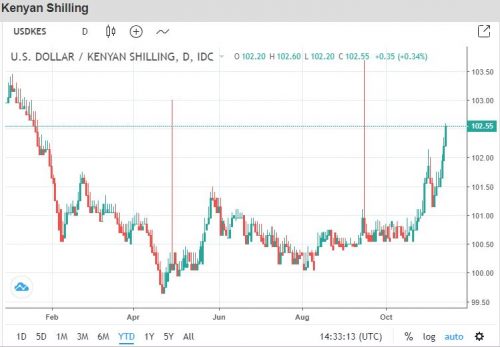“We are better off with a strong Shilling because our import to export ratio is around 3 to 1 and therefore, we are better off keeping a lid on prices via a strong currency.” Alykhan Satchu.
While policymakers insist on a sustained optimism on Kenya’s economic growth prospects, analysts are wary of what is happening though with mixed sentiments.
This is coupled with increased uncertainties in the global financial markets that has made the Kenyan Shilling (KES) fall by 0.1% against the US Dollar to close at Kshs 101.9, from Kshs 101.7 recorded the previous week, attributed to increased dollar demand from oil and import merchants.
Monday, the currency was quoted at lows of 102.50/60 to the US dollar, representing a 1.0% loss in just a week.
Cytonn Investments says, “The Kenya Shilling has appreciated by 1.3% year to date, and in our view, the shilling should remain relatively stable to the dollar in the short term.”
Alykhan Satchu, CEO Rich Management reiterates echoes the same, “After last month’s (October) correction, it remains positive versus the Dollar for the year, one of very few currencies in Africa and the world to have achieved such an outcome.”
“We tend to be fixated on the Dollar rate, but it’s worth looking at a trade-weighted index and what you will see is that the Shilling has in fact appreciated sharply against all its peers,” he adds. “In fact, I would posit, we are better off with a strong Shilling because our import to export ratio is around 3 to 1 and therefore, we are better off keeping a lid on prices via a strong currency.”

However, the persistent pressure is shining a spotlight on the Central Bank of Kenya’s Monetary Policy Committee (MPC) which is scheduled to seat on 27th November.
“Will the pressure on the shilling persist? Will the resultant inflation expectations be high enough to trigger a policy shift? For now it seems that, although tilted to the upside, risks are still somewhat measured to considerably alter inflation expectations,” Faith Atiti and Stephanie Kimani, CBA Group Financial Analysts note.
According to CBA, the persistent decline in foreign exchange reserves could imply efforts by the CBK in cushioning the local currency. Over the last one month, the reserves are down by USD 306Mn, to USD 8.15Mn (5.40 months of import cover). “While it remains a primary tool in managing the volatility, its continuous depletion underscores the need for other currency buffers.”
All along, the CBK has endeavored to maintain a stable exchange rate so that businesses can plan and not create problems for the financial institutions.
September during the last MPC meeting, the CBK foreign exchange reserves, currently stood at USD8,507 million (5.6 months of import cover) to provide adequate cover and a buffer against short-term shocks in the foreign exchange market.
“The current account deficit is expected to narrow to 5.4 percent of GDP in 2018 from 6.7 percent in 2017, with a strong performance of agricultural exports particularly tea and horticulture, resilient diaspora remittances, and improved receipts from services particularly tourism,” the MPC chair Dr. Patrick Njoroge had said.
Cytonn Investments also state high levels of forex reserves, currently at USD 8.2 bn, equivalent to 5.4-months of import cover, compared to the one-year average of 5.5-months will continue to support the shilling.
“That said, the need to contain further losses may see a more hawkish shift in guidance to suggest scope for tightening should the pressure persist. Even then, should Treasury go ahead with the planned Eurobond sale, then potentially enhanced reserves could help restore calm, eliminating the need for tightening,” CBA Analysts ask.
Alykhan Satchu concludes that “The Central Bank is sitting on the highest hard currency reserves in its history. Remittances have surged by 71.9% year on year to $266.2M in June 2018 from $54.9M in June 2017 by 71.9% year on year to $266.2M in June 2018 from $54.9M in June 2017.”
The shilling firmed 102.35/55 per dollar, compared with 102.50/70 at Monday’s close attributed to inflows from investors interested in buying government debt.
The central bank will auction an infrastructure bond worth Ksh 50 billion on Wednesday. The funds will be used for partial funding of infrastructure projects in roads, water, and energy sectors.
********
The amortized bond carries a coupon of 11.95% and will be open for only two days, 12th and 13th November. The 15-year IFB currently has an implied yield of 11.85%. Therefore, the 20-year bond may attract a higher yield although the upside may be capped by the risk of distorting the curve, within the current interest rate environment, as well as heavy liquidity in the market. We expect the bond to auction in the 12.05 -12.20% band, although the market could bid as aggressively as 12.50%.
For banks, while the tenor may not be attractive, appropriate pricing may generate some interest.
Yield expectations remain generally low despite concerns over renewed pressure on the currency. While short-term risks for the currency remain, anticipated Eurobond sale as announced by Treasury could help restore stability thus weakening prospects of monetary tightening.
Last three paragraphs from CBA Analysts Weekly Brief note




